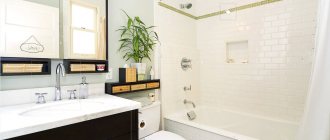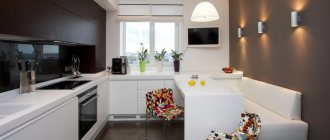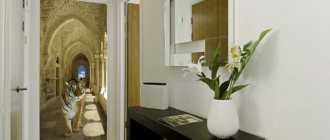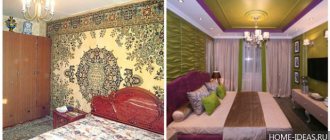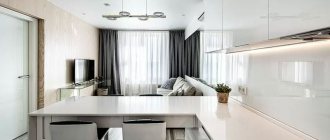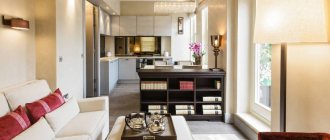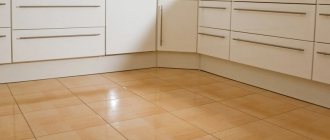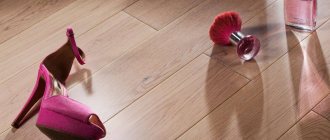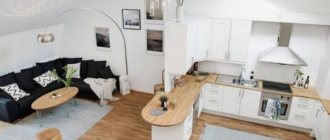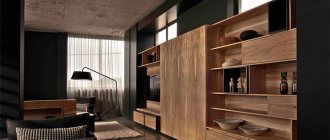Interior renovation
The hallway in a traditional concrete house is rectangular or square in shape. You can make changes to the design of this room by adding arches to the hallway.
Interior doors should be designed in the form of arches. Then the small hallway will look more aesthetically pleasing and softer. In a square corridor, an arch can completely expand the space if instead of the entrance to the hall there is only an arched flight.
An arched ceiling will help bring the hallway closer to the interior concept of palace classicism or neo-Gothic. And the entrance door in the shape of a pointed arch with a door leaf will be just a hit on the landing where it will be used.
The design of the corridor, decorated with stained glass windows, attracts a lot of attention. Illuminated stained glass windows on the walls will help to realize the interior design. Or stained glass drawings on interior doors. The construction of partitions at the entrance to a panel house, as a design technique, is used when it is necessary to separate any zone. For example, the space for outerwear can be covered with a beautiful screen, and the seat and table can be separated by a plasterboard partition.
Destruction of the blank walls of a house is possible if these walls are not load-bearing structures. Then you can completely remove one wall in the hallway so that it becomes a single space with the room adjacent to it.
The columns in the corridor look quite organic. They decorate the front door, or replace doorways leading to rooms. In addition, a small hallway can be made larger if you use light colors for decoration. The game of contrasts is also good here. Dark and white does not narrow the space, but adds to it the level of compression that is necessary.
The so-called “Brezhnevkas” have an undeniable advantage over the modern “Khrushchevkas”. Their entrance spaces are quite extensive. Therefore, you can create any interior ideas there.
Deciding on furniture
Functionality must come first. Otherwise, it is better to part with the furniture.
A classic white furniture set that seems to include every little detail.
To the age-old question “should I choose furniture to match the tiles,” the owners of this hallway in a panel house gave an unequivocal answer.
In hallway design, furniture often serves a decorative function. This is wrong: if furniture is not needed, then you should abandon its placement in favor of more free space.
The above remark may, of course, confuse you somewhat, but let’s be honest with ourselves: this hallway looks amazing without any cabinets, hangers, chests of drawers and other furniture “tinsel.”
When choosing furniture, pay attention to the fact that it complies with the rules of interior design. This is the only way you can achieve a high degree of presentability in your hallway.
Finishing materials
What to use to decorate the entrance area? The answer depends on the direction in the interior that was chosen as the main one. The loft style allows you to use natural stone, brick and painting. A modern style will require perfectly smooth walls, matte surfaces and plastic baseboards on the floor.
The floor at the front door can be decorated with tiles. The result is a bathroom that will not be difficult to keep clean.
Imitation stone is ideal for arches and openings. It’s better to make the ceiling of the hallway a single light canvas, so the space in it will become airier and wider.
To save space in the corridor, you can build a wardrobe. Then there will be even more space in it. And mirror surfaces are used in tiny corridors to solve problems with lighting and decoration there.
Plaster, wallpaper, laminate and plastic panels - in the hallway everything that can actually be used to decorate other rooms in the apartment is acceptable. Although there is one limitation that applies to most corridors. There it is better not to use floral wallpaper. They are incredibly forgiving of small to medium sized areas.
Floor
What could be the floor at the entrance? It is worth choosing the most practical and wear-resistant materials, because they will have to be washed quite often. For floor finishing, you can consider the following options:
- Laminate;
- Linoleum;
- Tile;
- Parquet;
- Carpet.
All of the above coatings have their own characteristics. Let's look at them in more detail:
| Coating | Peculiarities |
| Carpet | It gets dirty quickly, but looks expensive, requires frequent replacement due to regular abrasion, but holds liquid street dirt well. |
| Laminate | Does not tolerate moisture well, looks modern, fits any interior, and lasts a long time. |
| Parquet | Durable, but capricious material that requires careful care and a certain style in the interior. |
| Ceramic tile | A wear-resistant and durable option that is easy to care for. |
| Linoleum | Withstands almost any operating load, but has limitations in colors and patterns. Not suitable for all types of design. |
The choice of coating depends on the financial capabilities of the chooser, as well as on operating conditions. For a large family, where everyone leaves and comes from home several times a day, linoleum, tiles and laminate are suitable. For lower operational loads, carpet and parquet can be used.
Walls
The decoration of the walls in the corridor is of great importance. Like the bathtub, the corridor is subject to active use, so the walls there must be easy to clean and also withstand regular drafts.
A standard set of finishing materials for a hallway looks like this:
- Dye;
- Decorative plaster;
- Washable wallpaper;
- Cork;
- Stone and its imitation;
- Bamboo panels;
- PVC panels;
- Wooden panels;
- Mosaic or fresco.
Any type of the listed materials is easy to care for, lasts quite a long time, and looks presentable.
The finishing of the corridor should be carried out only with moisture-resistant and environmentally friendly materials. Otherwise, the repairs there will have to be redone in a year.
Combining materials for wall cladding is very popular. Wooden panels with wallpaper, stone and decorative plaster are the most common combinations in the interior of the hallway.
So 4 or 6 square meters will look much more interesting if you make niches on the walls and lay out mosaics. And the cork finishing method will be the most environmentally friendly, among others, if this notorious cork is placed correctly on the walls.
Ceiling
At the end of the 1970s, a standard series of houses p-44 was designed, with a ceiling height of 2.64 meters. This height is considered average, and with some interior ideas, it should be raised at least visually.
To make the ceiling in the hallway look higher, you need to choose a light shade for it. The layout in p44t is a little different from the houses of the 70s. According to the builders' plan, the ventilation duct is located in the hallway. With the height of the ceilings here, things are a little better; the standard height is 2.7 m. The design of a hallway with this height implies the possibility of playing with contrasts.
To decorate the ceiling, it is possible to use dark and light colors, stretch fabrics, plaster and stucco. Since the height of p44t allows this to be done.
But whatever the series of the house, plasterboard on the ceiling looks appropriate for ceilings of any height. Although simple painting also looks great.
Severe surface unevenness on the ceiling can be hidden only with hanging and overhead materials; when the ceiling is sufficiently smooth, painting and plaster are used to finish it.
In a large corridor, you can use a ceiling area to create a ceiling with transitions and projections. A small corridor always has straight lines and a minimum of details.
Decoration and materials for the hallway
Let's consider the materials that are suitable for finishing.
Floor
It is recommended to choose wear-resistant materials for the floor
Since the room is a walk-through room and cold will come from the front door, snow, dirt, etc. will be brought in with shoes. You can use linoleum, which is resistant to heavy loads, has a wide range and low pricing.
Ceramic tiles are also suitable. It is wear- and moisture-resistant, durable and beautiful. But there is also a minus, its slipping. Although the problem can be avoided by purchasing tiles with a rough surface.
Laminate flooring to look like natural wood shows good performance. And if you lay it across the corridor, the room will visually become wider.
If desired, you can also zone the hallway with flooring. Where they take off their shoes, ceramics are placed. And then, a cozy carpet and everything turns out comfortable and practical.
Walls
When decorating walls, experts advise choosing moisture-resistant materials. Moreover, they should be light shades. This will visually increase the space.
Washable wallpaper, decorative plaster, paint, and wall panels are suitable. It all depends on your desire.
The disadvantage of wall panels is that they steal the useful space of the hallway. Whereas decorative plaster can simultaneously act as insulation.
Washable wallpaper and decorative plaster are well suited for finishing a small corridor.
Ceiling
When choosing a ceiling structure for the hallway, you can be guided by the basic rules, as for any other room in a two-room or three-room apartment.
Stretch ceilings are good. Although you can make two-tier structures if the height of the room allows.
The ceiling can be suspended or simply plastered white
Lighting
Lighting at the entrance is subject to certain rules. To create a harmonious lighting system in the corridor, use the following tips:
- Combine main lighting with additional lighting;
- Highlight the most successful design solutions with light;
- Combine warm light with light interior colors;
- Place mirrors so that they indirectly diffuse the light, making it softer.
For suspended ceilings, it is best to use spotlights and LED strips. When the ceiling has regular plaster, you can diffuse the light using compact lamps arranged in a checkerboard pattern.
Furniture
The most difficult part of the hallway design work is furnishing. Small areas should be furnished in the spirit of minimalism, using built-in furniture. On a large square, a sofa would be appropriate. A standard set of boxes for storing shoes can be anything, the main thing is that it matches the room in color and shape.
Every hallway can be significantly improved with the right furniture. You can’t put a lot of it in the corridor, but there is always a way out. Therefore, for small corridors they came up with cabinets up to the ceiling, where everything you need fits behind mirrored doors.
Photo of a niche in the hallway
Read here Built-in furniture in the hallway: 70 photos, the optimal solution for small areas
Did you like the article? Share 
Narrow hallway design
A narrow corridor is not a death sentence for an apartment in a panel house, but a completely acceptable option for various types of decor. The narrow space must be divided into two zones: the entrance and the vestibule.
Zoning is done by laying the floor with different materials, as well as by painting and decorating the walls in different colors. The doors here can be replaced with an arch, it is also possible to make them sliding.
You just need to add bright colors to light colors in a narrow corridor. And you should choose furniture that can be placed along the walls without significant loss of space. Everything that can be mounted on the walls in a long corridor must be installed on shelves and various kinds of hanging compartments. With this approach, space savings are significant.
Minimalism, oriental style, Provence and classics are what are perfectly implemented in narrow hallways. A large mirror on one wall and furniture near the other will visually expand the space and make the ceilings higher. In all other respects, the narrow corridor has no restrictions.
Choosing the right finish
It’s hard to go wrong by calling wallpaper the most common finishing material for the walls of a modern hallway in a panel house. A remarkable fact: in an era of dominance of provocative designs and flashy tones, the good old classics continue to retain their charm and relevance.
In a dispute with ceramic tiles, even if laminate does not win, it continues to maintain stable parity. Its main advantages are ease of installation, good imitation of wood species, and high tactile comfort.
The combination of decorative plaster and classic wallpaper is found quite often in city apartments. Hallways decorated in this way radiate comfort and tranquility.
It’s quite possible to do without artificial stone in the hallway, but why, if it’s really better with it? This finishing material can be used both to decorate the entire wall of the room, and partially - in order to emphasize certain accents in the design.
Small hallway design
A small space at the entrance should be furnished with a minimal amount of decor. Another solution to the problem could be to combine this room with a common room by demolishing the partitions.
If the hallway is very small, it is possible to place a wall-mounted clothes hanger, a cabinet for small items and a mirror there. Everything else should be moved to a larger room.
Tiny corridors must be illuminated with bright lamps. Wall sconces alone will not be enough here. Another decor option is a mirrored ceiling. But not every owner is able to get used to this finishing method.
Remove everything ugly and dangerous from sight
Sometimes niches are specially planned so that they can accommodate all sorts of counters, panels and other technical elements that do not decorate the apartment, and in a small space can also be frankly in the way.
It is also useful to remove them if there is a child in the house: they can be very inventive in trying to get to the forbidden, and therefore a locked niche will protect both the baby and the entire apartment.
The design of a niche in the hallway with such a locked door is also designed in accordance with the general style of the room. It can even be disguised so that it becomes completely invisible.
Design of a large hallway
Not all storey buildings are equipped with large corridors. But where the squares of the hallway allow, you can use the provided meters to maximum benefit.
For example, houses for animals are made in the corridor so as not to place them in the main hall. Or they install a small seating area with a sofa and armchairs to welcome guests.
Some manage to organize a sleeping place in a large hallway, which is hidden in a wall or closet during the day. An extraordinary approach helps large families solve the problem of lack of square footage for each person.
The versatility of a niche in the hallway
Owners of their own homes who do not like ordinary cabinets and numerous shelving in the hallway may prefer a built-in wardrobe in the hallway niche. Advantages of such a solution:
- significant space savings;
- creating a place to keep the necessary things;
- saving money on purchasing expensive pieces of furniture.
Niches made of plasterboard in the hallway can be complemented by shelves made of glass or natural wood, and the design is very similar to the finished rack.
If you want a niche to decorate the corridor, then it is not necessary to adhere to certain geometric shapes.
Using your ideas, create an original ornament, complement it with exclusive lighting, applying several shades to the details of the niche using special paint.
By designing a niche in the hallway, you can successfully emphasize the taste preferences of the homeowners. If you correctly adhere to the nuances during the construction process, the design will visually expand the room.
Thanks to the characteristics of plasterboard, it is possible to build both classic rectangular structures and various arched models of complex shapes; the photo of a niche in the hallway in the presented catalog confirms this.
At the same time, the style of the niche must certainly be combined with the design of the corridor, only then the design will become its unsurpassed decor. Otherwise, it will be inappropriate in the interior space and will spoil the pleasant impression of the interior.
Design of a hallway with a storage room converted into a dressing room
In some corridors, storage rooms are located in the old fashioned way. Modern people no longer store car tires and jars of pickles there. They prefer to equip them as separate dressing rooms.
This solution allows you to avoid installing a separate closet in the hallway. And since the depth of such a pantry can be impressive, out-of-season items, boxes of shoes and any other accessories are placed in it.
A mirror in the doors of a former storage room will help transform it into a wardrobe. In addition, its doors can be disguised as the overall interior of the walls. And then every centimeter of the hallway will remain free for other interior solutions.
You can also install lighting in the former pantry to make choosing clothes as easy and pleasant as possible. Its interior decoration should be made similar to the exterior decor of the hallway. This way the corridor will acquire the most stylish and fashionable look.
The design of the hallway in a typical house is as complex as the design of the house area. It seems that a small space at the front door is quite easy to organize. But this statement is false, because the hallway is what guests see when entering the house, so it should be simply magnificent.
Repair and redevelopment in a panel house
Those who love a complete transformation of their personal space often undertake renovations and redevelopment. This implies:
- Partial or complete dismantling of walls and partitions;
- Redistribution of functional areas;
- Relocation of doorways;
- Combining the area of rooms;
- Expansion of some premises by reducing the area of others.
In order for a small hallway to meet the requirements, you should adhere to rules that can change its functionality and appearance.
It is not recommended to begin serious reconstruction without involving the services of construction companies. This is necessary so as not to risk the lives of the residents of the panel house. The essence of the redevelopment is the redistribution of the usable area of adjacent rooms, which will significantly transform the design of a small hallway in an apartment in a panel house.
It has been noticed that the use of dark colors when decorating a small room makes it gloomy and visually reduces its size.
Often, when modernizing a Khrushchev building, zoning techniques are used to separate functional corners. This can be a partial partition made of plasterboard or glass doors up to the ceiling. In addition to stationary partitions, this can be a folding bar counter between the hallway and the dining room, as is often done in a studio apartment.
Light shades expand the room, and mirrored or glossy surfaces push the boundaries even further, which is clearly visible in the photo.
Favorite design techniques for the reconstruction of panel houses include:
- Arches;
- Sides;
- Niches;
- Curved openings;
- Pass-through racks;
- Partitions in the form of a folding accordion.
These openings can be decorative elements, but often they are also shelves, seats and other functional interior elements.
Tips for organizing repairs and redevelopment.
- Make a plan for the hallway renovation.
- Take permission from the BTI and other supervisory authorities of the city government.
- Specify which walls are load-bearing and which are secondary.
- Plan to renovate two adjacent rooms at once, with the partition between them removed.
- Before demolishing the partition, turn off the lights and dismantle the electrical wiring on the wall for demolition.
- Plan new lighting.
- Think in advance about what the new floor covering will be like; most likely, you will have to adjust the screed and level the surface.
- The secondary part of the redevelopment is the choice of finishing materials and color scheme.
Decorating the walls and ceiling affects the entire design of the hallway in an apartment in a panel house. It is important to choose practical materials; on the floor, preferably abrasion-resistant coatings, such as porcelain tiles and moisture-resistant laminate.
Furniture should be purchased in the selected range or one or two tones different from the main color, unless a contrasting combination has become the finishing rule.
Don’t forget about techniques for visually enlarging small spaces. A well-thought-out lighting design, light cladding, photo wallpaper and mirrors will help with this. The priority is functional items and furniture with excellent aesthetic properties. As an example, see the photo of the design of a narrow corridor in an apartment in a panel house.
When choosing accessories and decor, try to buy ones that match the style of the interior.
